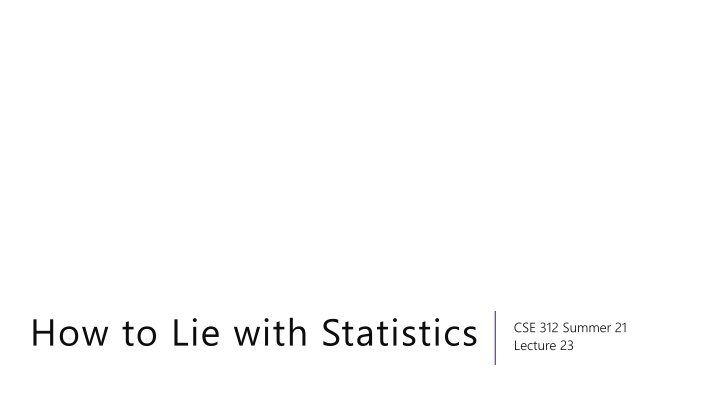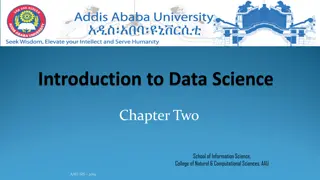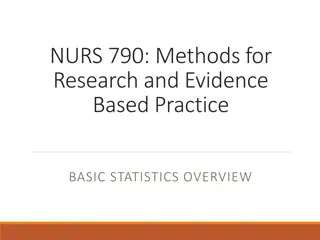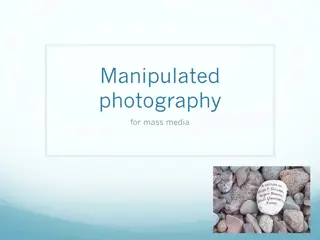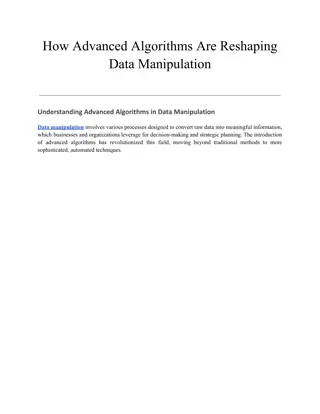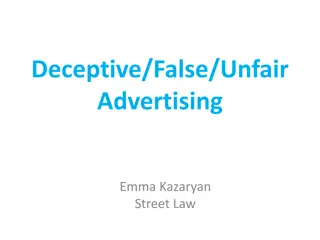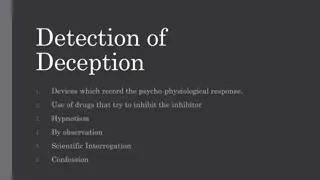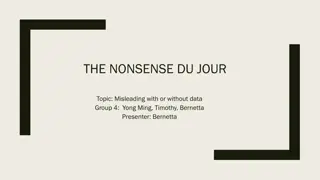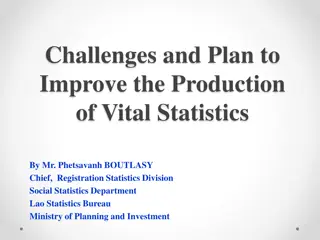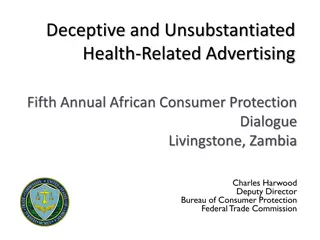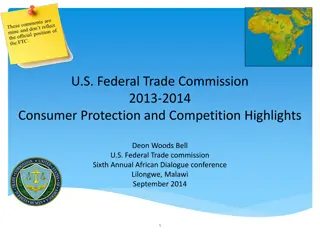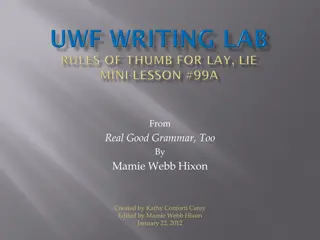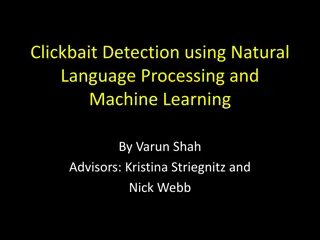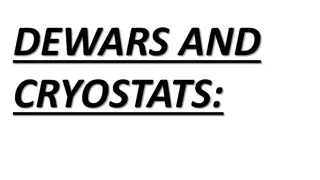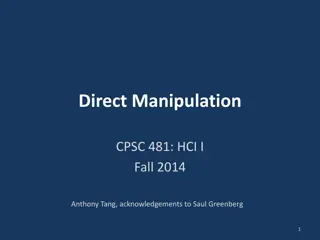How to Lie with Statistics: Uncovering Deceptive Data Manipulation
Explore the deceptive world of statistics and how they can be used to mislead. Learn about the marriage of math, science, and art in making sense of data. Discover examples of biased sampling leading to inaccurate predictions, as showcased in the 1936 election attempt by The Literary Digest Magazine. Uncover the importance of context in understanding numbers and safeguarding against manipulation.
Download Presentation

Please find below an Image/Link to download the presentation.
The content on the website is provided AS IS for your information and personal use only. It may not be sold, licensed, or shared on other websites without obtaining consent from the author.If you encounter any issues during the download, it is possible that the publisher has removed the file from their server.
You are allowed to download the files provided on this website for personal or commercial use, subject to the condition that they are used lawfully. All files are the property of their respective owners.
The content on the website is provided AS IS for your information and personal use only. It may not be sold, licensed, or shared on other websites without obtaining consent from the author.
E N D
Presentation Transcript
How to Lie with Statistics CSE 312 Summer 21 Lecture 23
Announcements Upcoming Deadlines : Review Summary 3 Final Released Problem Set 7 Final Key Released Final Interviews Friday, Aug 13 (TONIGHT!) Friday, Aug 13 (TONIGHT!) Monday, Aug 16 Tuesday, Aug 17 Wednesday - Friday, Aug 18 - 20 (TONIGHT!) (TONIGHT!) Office Hours will go until Wednesday Use Ed for finals discussions exclusively! No discussion in Office Hours. More logistics posted on Ed as a pinned post later today.
How to Lie with Statistics Darrell Huff Published in 1954, over 500000 copies sold Doesn t teach how to lie with statistics, but how we are/can be lied to using statistics In the current age, we are lied to by the media, by politicians, and marketers. Often make decisions due to it: 4 out of 5 dentists recommend . Today s lecture is heavily inspired by the book and similar examples available on the internet. If you like this lecture, please check out INFO 270 (https://www.callingbullshit.org/)
What is Statistics? A way to make sense of information from data Framework for thinking, for reaching insights, and solving problems. Numbers alone mean very little without context Statistics is a marriage of: Math Science Art
Facts are stubborn things, but statistics are pliable. Mark Twain This Photo by Unknown Author is licensed under CC BY-SA
Sampling Gone Wrong (Bias) The Literary Digest Magazine wanted to predict the 1936 election. Alfred Landon vs Franklin D Roosevelt Sent 10 million surveys and received 2.4 million responses The people contacted were: o Subscribers of the Literary Digest o Owners of cars and telephones Electoral Votes Prediction Actual Landon 370 Roosevelt 161
Sampling Gone Wrong (Bias) The Literary Digest Magazine wanted to predict the 1936 election. Alfred Landon vs Franklin D Roosevelt Sent 10 million surveys and received 2.4 million responses The people contacted were: o Subscribers of the Literary Digest o Owners of cars and telephones Electoral Votes Prediction Actual Landon 370 8 Roosevelt 161 523 What went wrong? What went wrong?
Sampling Gone Wrong (Bias) Not Representative Voluntary Response Bias o Only 24% of respondents answered the poll Not the Right Populations o Was biased towards people with more money, education, information, alertness than the average American Not Random Convenience Sampling o Only people whose contact information was available o Standing outside a church and asking, Do you believe in God? , and then using the result of this sample to represent the beliefs of the entire US population. More samples is NOT a solution for a bad sampling technique
The Well-Chosen Average Mean: Mean: Average of all values weighted by probability or density Median: Median: The point m where values are larger and are smaller Mode: Mode: The point with the highest probability or density Let ?~???(?). ?[?] =1 ??????(?) =ln 2 ? ? ???? ? = 0
The Well-Chosen Average Mean: Mean: Average of all values weighted by probability or density Median: Median: The point m where values are larger and are smaller Mode: Mode: The point with the highest probability or density Let ?~?(?,?2). ?[?] = ? ??????(?) = ? ???? ? = ?
Are haircuts more expensive in Vancouver or Toronto? Vancouver Saloon Vancouver Toronto Toronto $20 1 $20 $15 $15 $20 2 $20 $25 $25 $22 3 $22 $25 $25 $24 4 $24 $29 $29 $25 5 $25 $35 $35 $28 6 $28 $45 $45 $400 7 $400 $65 $65 What do you think? What do you think?
Are haircuts more expensive in Vancouver or Toronto? Saloon Vancouver Toronto 1 $20 $15 2 $20 $25 3 $22 $25 4 $24 $29 5 $25 $35 6 $28 $45 7 $400 $65 Mean $77 $36 Median $24 $29 Mode $20 $25 What do you think now? What do you think now?
The Well-Chosen Average Mean: Mean: Heavily affected/influenced by outliers. Any extreme value(s) may make this measure terrible Median: Median: About half the values are higher than this, and half are lower than this Mode: Mode: Most frequently occurring value Which one is the best? Which one is the best? It depends, and it is good to know all of them for a better idea of the distribution. It is good to know all - mean, median, and, mode - for a better idea of the distribution.
Sample Size Too Small Senserdime (toothpaste company) claims 86% of dentists recommend their product. Sounds very impressive. Would you buy a Would you buy a Senserdime Senserdime toothpaste? toothpaste?
Sample Size Too Small Senserdime (toothpaste company) claims 86% of dentists recommend their product. Sounds very impressive. 86% out of how many dentists? o6 7 = 86% o30 35 = 86% o600 700= 86%
Sample Size Too Small Senserdime (toothpaste company) claims 86% of dentists recommend their product. Sounds very impressive. 86% out of how many dentists? o6 7 = 86% [0.7664,0.9479] o30 35 = 86% [0.8166,0.8977] o600 700= 86% 0.8481,0.8662 These are the 95% confidence intervals for the above
Colgate 2007 Ad Campaign In 2007, Colgate advertised that more than 80% of dentists recommended their toothpaste. How would you read this Ad Campaign? More than 80% dentists recommend Colgate over over other toothpaste brands OR OR More than 80% of dentists recommend Colgate among among other toothpaste brands
Colgate 2007 Ad Campaign More than 80% dentists recommend Colgate over This may imply that only 20% of dentists recommend toothpaste that are from brands other than Colgate over other toothpaste brands More than 80% of dentists recommend Colgate among This means that more than 20% of dentists recommend toothpaste that are from brands other than Colgate where a dentist can recommend more than 2 brands among other toothpaste brands
Correlation Causation? People who use Senserdime generally have less cavities than those who use generic brands Can we say Can we say Senserdime Senserdime prevents cavities ? prevents cavities ?
Correlation Causation? People who use Senserdime generally have less cavities than those who use generic brands Can we say Can we say Senserdime Senserdime prevents cavities ? prevents cavities ? Turns out that a tube of Senserdime costs $1000. o This means that only wealthy people can afford it. o Wealthy people have access to good healthcare and hygiene o They are less likely to get cavities. o Therefore, Therefore, Senserdime Senserdime did not do anything! did not do anything!
Correlation Causation? When ice cream sales go up, umbrella sales go down
Correlation Causation? When ice cream sales go up, umbrella sales go down Both generally happen in the summer An increase in ice cream sales did not CAUSE umbrella sales to go down. The weather CAUSED both of these things to happen Correlation DOES NOT imply Causation!
Medical Tests Abbott s test for COVID-19 is 99% accurate, and we know that 0.005% of the population has the disease. If you test positive, the probability you have the disease is?
Medical Tests Abbott s test for COVID-19 is 99% accurate, and we know that 0.005% of the population has the disease. If you test positive, the probability you have the disease is? (+|?) (?) ? + = (+|?) ? + (+|??) (??) 0.99 0.00005 = 0.99 0.00005+0.01 0.9995 0.49% Much lower than it seems at first glance!
Biased Carnival? Suppose there is a carnival game which gives out prizes, and three types of players: children, teenagers, and adults. Justin thinks the carnival unfairly gives more prizes to children over the other types of players. Is this true? Is this true? Player Type % Prizes Won Child 70% Teenager 5% Adult 25%
Biased Carnival? Suppose there is a carnival game which gives out prizes, and three types of players: children, teenagers, and adults. Justin thinks the carnival unfairly gives more prizes to children over the other types of players. Is this true? Is this true? Player Type % Prizes Won Child 70% Teenager 5% Adult 25%
Biased Carnival? Suppose there is a carnival game which gives out prizes, and three types of players: children, teenagers, and adults. Justin thinks the carnival unfairly gives more prizes to children over the other types of players. Player Type % Prizes Won % Global Population Child 70% 25% Teenager 5% 15% Adult 25% 60% How about now? How about now?
Biased Carnival? Suppose there is a carnival game which gives out prizes, and three types of players: children, teenagers, and adults. Justin thinks the carnival unfairly gives more prizes to children over the other types of players. Player Type % Prizes Won % Global Population % Carnival Population Child 70% 25% 71% Teenager 5% 15% 4.5% Adult 25% 60% 24.5% This looks very fair now! This looks very fair now!
Biased Carnival? Player Type % Prizes Won % Global Population % Carnival Population Child 70% 25% 71% Teenager 5% 15% 4.5% Adult 25% 60% 24.5% This looks very fair now! This looks very fair now! Player Type and Prize won are (almost independent) ? ??? ????? ???) = 0.7 ???????? ????? ???) = 0.05 ????? ????? ???) = 0.25 (? ???) = 0.71 ???????? = 0.045 (?????) = 0.245
Simpsons Paradox An analysis of the admission rates for the UC Berkeley grad school in 1973 is a great example of Simpson s Paradox. Applicants Admitted Men 8442 44% Women 4321 35% Total 12763 41% Was the office of admissions unfair? Was the office of admissions unfair?
Simpsons Paradox Department Men Women Total Applicants Admitted Applicants Admitted Applicants Admitted A 825 62% 108 82% 933 64% B 560 63% 25 68% 585 63% C 325 37% 593 34% 918 35% D 417 33% 375 35% 792 34% E 191 28% 393 24% 584 25% F 373 6% 341 7% 714 6% How about now? How about now?
Simpsons Paradox Simpson's paradox is a phenomenon in probability and statistics in which a trend appears in several groups of data but disappears or reverses when the groups are combined.
Gamblers Fallacy Play another round of blackjack you have to win soon! You have been losing too much! Each game is independent, independent, and so even if you already lost 10 times, the probability of you winning the next game is the same as any other Remember Memorylessness property for Geometric RV! ??? 1000 ??????) = ??? 10 ??????) = (???)
How to better understand Statistics? 1. Who says so? 2. How do they know this is true? 3. What s missing? 4. Did somebody change the subject? 5. Does it make sense?
Conclusions 1. 2. Ask if the statistic represents the mean, median, or mode. 3. Inquire about the size of the sample relative to the population, and/or ask for a confidence interval. 4. Correlation does not imply causation. 5. Check the distribution of the samples (are they uniform, or not)? 6. Interpret conditional probabilities properly. Intuition sometimes doesn t work here! 7. Does the data give you the full picture? If there are subcategories, enquire into them! 8. Independent events! Don t gamble, ever. Determine if the samples are random random and representative representative.
95.73% of all statistics are made up! - Kushal Jhunjhunwalla This Photo by Unknown Author is licensed under CC BY-SA-NC
